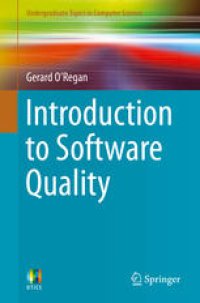
Ebook: Introduction to Software Quality
Author: Gerard O’Regan (auth.)
- Tags: Programming Techniques, Software Engineering, System Performance and Evaluation, Management of Computing and Information Systems, Mathematical Logic and Formal Languages
- Series: Undergraduate Topics in Computer Science
- Year: 2014
- Publisher: Springer International Publishing
- Edition: 1
- Language: English
- pdf
This textbook describes the approaches used by software engineers to build quality into their software. The fundamental principles of software quality management and software process improvement are discussed in detail, with a particular focus on the CMMI framework. Features: includes review questions at the end of each chapter; covers both theory and practice, and provides guidance on applying the theory in an industrial environment; examines all aspects of the software development process, including project planning and tracking, software lifecycles, software inspections and testing, configuration management, and software quality assurance; provides detailed coverage of software metrics and problem solving; describes SCAMPI appraisals and how they form part of the continuous improvement cycle; presents an introduction to formal methods and the Z specification language; discusses UML, which is used to describe the architecture of the system; reviews the history of the field of software quality.
In order to maintain strong levels customer satisfaction and loyalty, software developers face considerable pressure to meet expectations for high-quality software products that are consistently delivered on time.
Introduction to Software Quality describes the approaches used by software engineers to build quality into their software. The fundamental principles of software quality management and software process improvement are discussed in detail, with a particular focus on the capability maturity model integration (CMMI) framework.
Topics and features:
- Includes review questions at the end of each chapter
- Covers both theory and practice, in addition to providing guidance on applying the theory in an industrial environment
- Examines all aspects of the software development process, including project planning and tracking, software lifecycles, software inspections and testing, configuration management, and software quality assurance
- Provides detailed coverage of software metrics and problem solving
- Describes SCAMPI appraisals and how they form part of the continuous improvement cycle
- Presents an introduction to formal methods and the Z specification language, which are important in the safety critical field
- Discusses UML, which is used to describe the architecture of the system
- Reviews the history of the field of software quality, highlighting the pioneers who made key contributions to this area
This clearly written and easy-to-follow textbook will be invaluable to students of computer science who wish to learn how to build high-quality and reliable software on time and on budget. Software engineers, quality professionals and software managers in industry will also find the book to be a useful tool for self-study.